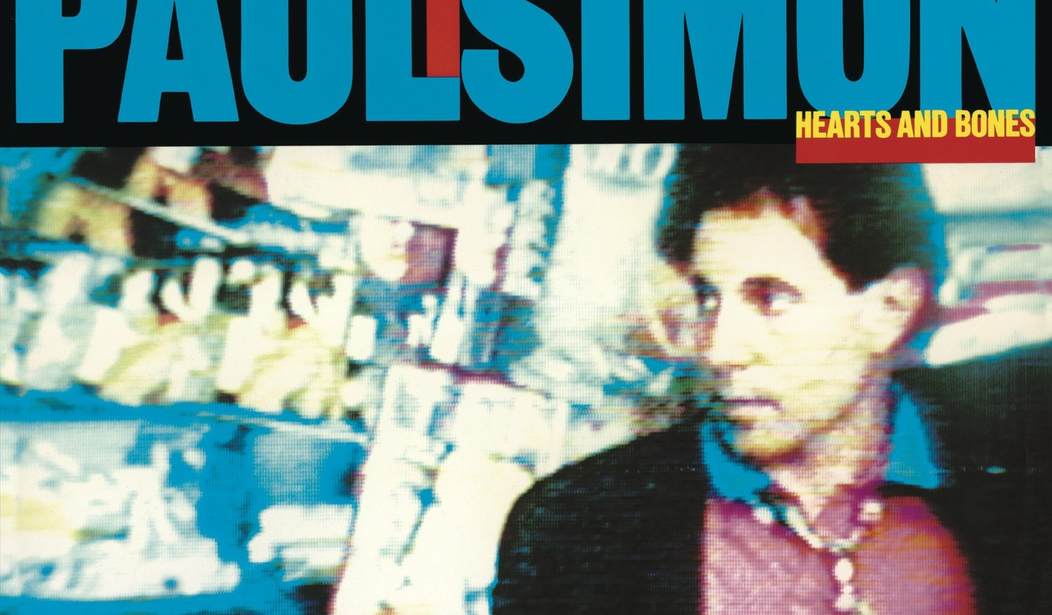"Hearts and Bones" is the album that relaunched Paul Simon's career to all-new heights by crashing and burning.
It was impossible to know that when came out in 1983, although in part because I had no idea it had come out. Three years earlier, at the tender age of 11, I decided I was a Simon fan after catching the video on some TV show or other for "Late In The Evening," one of just two hit singles (and one only barely) from Simon's previous album, "One Trick Pony." Even as a kid, I loved Caribbean sounds, and "Late In The Evening" is chock full of semitropical brass. Plus Steve Gadd doing ...something... on drums in that song that I can't explain but dearly love.
But I digress.
"Hearts and Bones" was originally supposed to take its title from the first track on Side B, "Think Too Much." And maybe Simon did think too much when writing this album. Lyrically and musically, he's in fine form here through all ten songs, but nothing jumps out and says "RADIO STATIONS MUST PLAY THIS," so radio stations largely didn't.
When PopMatters reviewed the "Hearts and Bones" re-release in 2012, David Bloom called it "riskier, both musically and lyrically [than 'One Trick Pony'] and more engrossing for it." But, he wrote, "The album is so tied to Simon’s escalating preoccupation with physical and emotional remoteness that it’s hard to imagine anyone being surprised when it failed to move a fan base waiting for the next 'Late in the Evening.'"
I'm guilty as charged on that score. I was well into my 30s before I gained an appreciation for "Hearts and Bones."
Maybe it's just one of those albums that you have to spend a little time in the emotional wilderness with the "one and one-half wandering Jews" of the album's title track before you even want to give it a fair shake. But I'm so glad I finally did.
The song wistfully describes "the arc of a love affair" and, of course, arcs always bend back down to Earth. Simon's short marriage (and long, rocky love affair) with Carrie Fisher was falling apart at the time he wrote it.
The first song to catch my ear, however, was "Train in the Distance," a tale of courtship, marriage, and divorce that features some of Simon's most artful storytelling.
Now the man and the woman / Remain in contact / Let us say it's for the child
With disagreements about the meaning / Of a marriage contract / The conversation's hard and wild
But from time to time / He makes her laugh / She cooks a meal or two
The first meal she cooks would be dinner. The second one, breakfast. And we can be certain what happened in between. In just six words set up by a couple of lines, Simon has told us everything about their bittersweet post-divorce relationship. Brilliant.
Exclusively for Our VIPs: Florida Man Friday: Urine for a Real Treat This Week
Then there's the unexpectedly poetic mouthful of "Rene and Georgette Magritte With Their Dog After the War." It's a tender and surrealistic ballad — one of his finest yet least-known — inspired by a photo of the Belgian surrealist artist Rene Magritte and his wife. "That was a caption of a photograph I was reading, and I thought, ‘That’s an interesting title for a song,’” Simon said in a 1984 Playboy interview. “After I got the phrase, I began to sing a melody that fit it. I didn’t have an instrument. I just sang it."
It's lovely.
I wrote at the start of this column that "Hearts and Bones" helped launch Simon's career to all-new heights, and now I owe you an explanation for how "a commercial disaster," as AllMusic put it, did such a thing.
Simon told the story — I'll paraphrase briefly — on the "Classic Albums" documentary series about what happened after "Hearts and Bones" went nowhere just as his marriage ended.
He figured his career was pretty much over. He took to aimlessly driving around New York. A friend had given him a demo cassette that he couldn't stop listening to during his drives. It was of a then-unknown South African band, Ladysmith Black Mambazo.
Figuring no one one notice if he slipped off to Africa for a bit, Simon went there to jam with LBM, and those sessions would form the core of what became his Grammy-winning, record-smashing 1986 tour du force, "Graceland."
Not bad for a guy who'd just spent a year thinking too much about his failures.
P.S. There's no way music columns like these would be possible without your VIP support. Thank you so much for providing the opportunity to share things like these with you.










